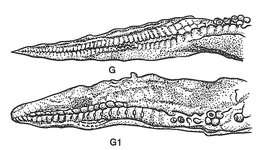- Joined
- Nov 19, 2002
- Messages
- 4,674
I've been away for a few days, sorry.
I'd maintain absolutely no trace of hectocotylisation on any arm (I've not seen anything remotely 'hectocotylised' at any rate - certainly not comparable to that on other taxa for which the hectocotylus is very pronounced).
You'd have to be very careful when referring features found on both ventral arms to hectocotylisation.
I'd maintain absolutely no trace of hectocotylisation on any arm (I've not seen anything remotely 'hectocotylised' at any rate - certainly not comparable to that on other taxa for which the hectocotylus is very pronounced).
You'd have to be very careful when referring features found on both ventral arms to hectocotylisation.



